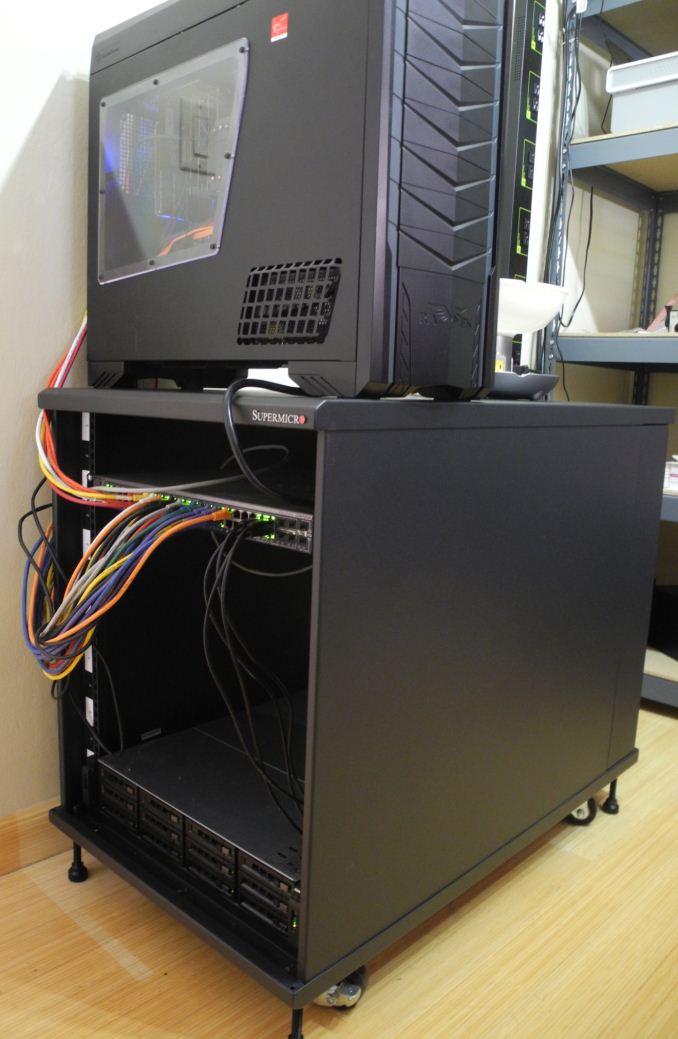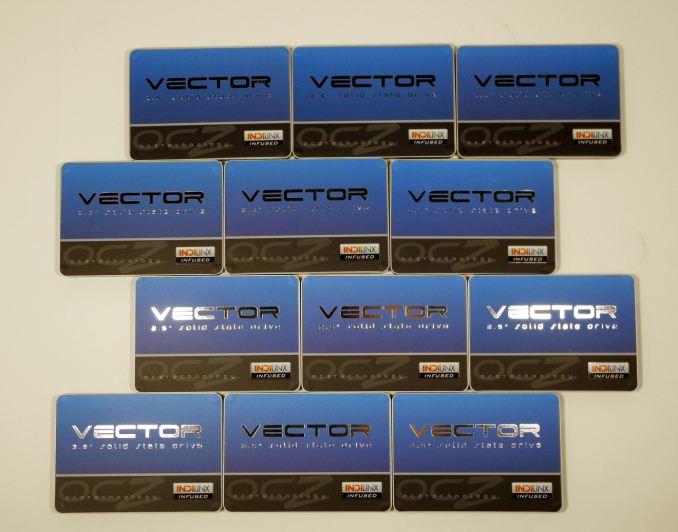QNAP's TS-EC1279U-RP 12-bay Flagship Rackmount NAS Review
by Ganesh T S on April 29, 2013 4:30 PM EST- Posted in
- Enterprise
- Storage
- NAS
- QNAP
Testbed Setup and Testing Methodology
Our rackmount NAS testbed uses the same infrastructure and methodology as the other units with a tower form factor. Performance evaluation is done under both single and multiple client scenarios. In the multiple client scenario, we run tests with two ports teamed with the second pair used as a backup and also with all four ports teamed with 802.3ad dynamic link aggregation. For these tests, we use the SMB / SOHO NAS testbed described earlier.
| AnandTech NAS Testbed Configuration | |
| Motherboard | Asus Z9PE-D8 WS Dual LGA2011 SSI-EEB |
| CPU | 2 x Intel Xeon E5-2630L |
| Coolers | 2 x Dynatron R17 |
| Memory | G.Skill RipjawsZ F3-12800CL10Q2-64GBZL (8x8GB) CAS 10-10-10-30 |
| OS Drive | OCZ Technology Vertex 4 128GB |
| Secondary Drive | OCZ Technology Vertex 4 128GB |
| Tertiary Drive | OCZ RevoDrive Hybrid (1TB HDD + 100GB NAND) |
| Other Drives | 12 x OCZ Technology Vertex 4 64GB (Offline in the Host OS) |
| Network Cards | 6 x Intel ESA I-340 Quad-GbE Port Network Adapter |
| Chassis | SilverStoneTek Raven RV03 |
| PSU | SilverStoneTek Strider Plus Gold Evoluion 850W |
| OS | Windows Server 2008 R2 |
| Network Switch | Netgear ProSafe GSM7352S-200 |
Thank You!
We thank the following companies for helping us out with our NAS testbed:
- Thanks to Intel for the Xeon E5-2630L CPUs and the ESA I-340 quad port network adapters
- Thanks to Asus for the Z9PE-D8 WS dual LGA 2011 workstation motherboard
- Thanks to Dynatron for the R17 coolers
- Thanks to G.Skill for the RipjawsZ 64GB DDR3 DRAM kit
- Thanks to OCZ Technology for the two 128GB Vertex 4 SSDs, twelve 64GB Vertex 4 SSDs and the RevoDrive Hybrid
- Thanks to SilverStone for the Raven RV03 chassis and the 850W Strider Gold Evolution PSU
- Thanks to Netgear for the ProSafe GSM7352S-200 L3 48-port Gigabit Switch with 10 GbE capabilities.
Our testing environment also required some updates for evaluation of rackmount units. Supermicro was gracious to loan us their mini rack (CSE-RACK14U). An interesting aspect of the mini rack is the fact that its height is that of the standard workplace desk (30.64"). This allowed us to use our existing NAS testbed (tower form factor) and power measurement unit easily along with the rackmount components (the NAS under test, the Netgear ProSafe switch etc.)
We have been using the Western Digital 4TB RE (WD4000FYYZ) disks as test hard drives for NAS reviews. As we saw in our previous reviews, RAID rebuilds take days to get done. With a large number of bays, usage of hard disks was going to be very cumbersome. In addition, hard disks just don't bring out the performance potential of the rackmount units. Therefore, evaluation of the QNAP TS-EC1279U-RP was done by setting up a RAID-5 volume with twelve OCZ Vector 4 120 GB SSDs. Various shares and iSCSI LUNs were configured in this 1285 GB volume.
Thank You!
We thank the following companies for helping us out with our rackmount NAS evaluation:
- Thanks to Supermicro for the CES-RACK14U mini rack
- Thanks to OCZ Technology for the twelve 120 GB Vector SSDs.
In order to evaluate single client performance, we booted up one VM in our testbed and ran Intel NASPT on the CIFS share in the NAS. iSCSI support evaluation was also done in a similar manner with a 250 GB iSCSI LUN mapped on the VM. For NFS, we ran IOMeter benchmarks in Linux. For evaluation of multiple client performance, we accessed a CIFS share from multiple VMs simultaneously using IOMeter and gathered data on how the performance changed with the number of clients / access pattern. Without further digression, let us move on to the performance numbers.












23 Comments
View All Comments
mschira - Monday, April 29, 2013 - link
I was wondering if one could install a proper Linux on these systems, such as Fedora.Then one could use it as a medium powerful computation server with lot's of local storage.
Has anybody tried that?
Cheers
M.
watersb - Monday, April 29, 2013 - link
It's a bit late for coffee, so please forgive me for not finding a price in the review.This looks like an interesting product, but I'm a ZFS zealot. Running ZFS with only 4 GB RAM isn't going to fly.
That said, I am *very* interested in anything resembling a mid-range NAS. Storage is a real pain point, and it is tough to build acceptable storage out of cheap disks. So thanks for reviewing this thing!
ganeshts - Monday, April 29, 2013 - link
Price is $5K (MSRP), but retailers are selling it at prices ranging from $3500 to $5000davegraham - Tuesday, April 30, 2013 - link
Watersb,Use Nexenta Community Edition (uses OpenIndiana + ZFS) on top of a supermicro server with the same 12 drive bays (and SAS drives) and I'd kill this particular box AND have a more robust solution to boot.
D
watersb - Tuesday, April 30, 2013 - link
Thanks, Ganesh, for the pricing info.Dave, that's such a good idea, I switched to OpenIndiana in 2009. I'm running 8 2TB drives as four mirrored pairs with a $100 LSI controller. But it will be quite some time before I have the budget to upgrade to a server motherboard with more than 16GB ECC RAM.
ZFS deduplication is *expensive*, folks. Don't do it. I tried adding a 60Gb SSD for L2ARC but it turns out that I would be better off with 60GB of *swap* to hold the deduplication tables.
My kung fu is weak. But I've been running this system through numerous hardware failures, PEBKAC events, and system software updates, and I haven't lost any data. Solaris isn't bulletproof, but it does warn me of impending drive failures before I lose anything.
Sorry for the long rant -- but it IS possible to play with "enterprise" class system configurations on lousy hardware if you are willing to waste^W commit some time doing so.
Walkeer - Thursday, May 9, 2013 - link
I do not understand either why such powerful NAS has only 4GB or RAM looking at the RAM prices these days...davegraham - Monday, April 29, 2013 - link
can you please nix the usage of the word "enterprise" from your reviews? These QNAP boxes (and pretty much any other storage device y'all review these days) are Commercial, SMB, or Consumer level devices at best. Enterprise describes a category of business that would never use this based on uptime, data integrity, performance, and capability requirements.ganeshts - Monday, April 29, 2013 - link
Hmm.. Not sure why you are doubting the performance and capability of these units. With SSDs, they form a very good storage backend for medium sized work groups. Uptime and data integrity - These need more QA, but with the stable firmware version, I really had no trouble keeping it bombarded with data accesses for days togetherGigaplex - Monday, April 29, 2013 - link
Read your very own "cons" section. This is exactly why Enterprise wouldn't look at it. As for performance? I've got a dirt cheap home build Llano box using 5 WD Green drives in software RAID 5 and it easily reaches 250-300MB/s transfers. This system had 12 SSDs. Colour me underwhelmed.Walkeer - Thursday, May 9, 2013 - link
I understand you have 10Gb network at home right? Or InfiniBand 4x perhaps? Else I do not see how you push 300MBps over 1Gb line... or you are talking about your desktop? Man, this article is about NAS...